Europe 2010/11 third leg: Spain and Italy
In transit: Montpellier to Barcelona
Possibly due to administrative issues, there was no direct train from Montpellier to Barcelona. Instead, one must catch a French-run train to Figueres, past the French-Spanish border, then transfer - literally metres away on the adjacent platform - to a Spanish-run train to Barcelona.
As the train sped towards Spanish territory some blue began to emerge from the gloomy skies, and looked more promising this time. When I changed trains at Figueres, the sun was well and truly out. I got excited about the prospect of finally spending at least an afternoon outside in well-lit conditions.
One thing I immediately noticed upon boarding the Spanish train was the number of different languages used for announcements - four instead of three. The French train had announcements read out three times, one each in French, Spanish, and English, while the connecting train had an extra repetition of announcements, this time in Catalan.
Barcelona: The city that never sleeps (except during siesta)
I had been to Europe twice before, but not once had I stepped foot on Spanish soil. It was a bit of an oversight, I will concede. One of my priorities for this trip was to finally tick it off the list.
In case you've never heard of the place, Barcelona is the second largest city in Spain (after Madrid) and is the capital of Catalonia. It's a very old city (over 2000 years old, supposedly) that is also very modern, thanks in part to the 1992 Olympics, which it hosted.
The weather was brilliant when I stepped out of the Metro - blue skies and warm enough to go around in a t-shirt, which is amazing for the middle of winter. Because of this, I picked up the pace on the way to my hostel so I could spend the rest of the afternoon exploring. I was staying in Barri Gòtic, the Gothic Quarter of Ciutat Vella, which is Barcelona's old town (the name translates to old city in Catalan). It was a nice area to be staying, with the Gothic architecture attracting many tourists. I had a good walk around to get a feel for the place then had a pretty ordinary dinner at a fast food place with a surprisingly decent beer list.
Staying on the topic of beer for a little bit, Barcelona is not exactly renowned for its craft beer scene. Most places will sell you Estrella Damm, the local beer that has been brewed in the city since 1876. Thanks to BeerAdvocate, I found a place near my hostel called La Cerveteca that stocked a good range of bottled beers as well as a few on tap. The highlight for me was the Great Divide Yeti, which I had tried in London earlier in the trip and is still, to this day, one of my favourite stouts. Sadly, the place closed at 10:30pm, which is very early for Barcelona. And I do mean very early.
I don't know if this is a symptom of the siesta, but people in Barcelona seem to start their night very late and party hard and long well into the morning. When I got back to the hostel after my beer hunt, I tagged along with a group of people who headed to a club in another part of the city. The place was just starting to get busy when we arrived. Clubs not really being my thing, I must have left at around 1 or 2am, but I think some stayed until 5am or later.
I spent most of the next day checking out Gaudí architecture as part of a walking tour. Antoni Gaudí was a Catalan architect most famous for designing the Sagrada Família, a breathtaking church that is one of the main tourist draws of Barcelona. The church is so massive in scale and complexity that it was not completed in Gaudí's lifetime. In fact, it is still a work in progress, with the expected completion date being 2026, the centennial of Gaudí's death. The construction work did not deter the crowds and, because of this, none of us bothered to join the lengthy queue to go in.
Apart from the Sagrada Família, where our tour ended (and a fitting end it was), Gaudí also designed many other buildings around Barcelona, and the tour took us to these places while talking a bit about the architect's life and work. One place the tour did not go, because it was too far away, was Park Güell, a garden complex designed by Gaudí. Three of us decided to make the trek there, which involved walking up a hill after taking the Metro. It was worth the effort as the place featured impressive architecture and had a festive atmosphere thanks to the favourable weather.
After a long morning and afternoon of walking around, I did as the locals do and had a siesta back at the hostel, waking up just in time for dinner. The same people who ran the walking tours during the day were meant to run a pub crawl that night, but interest was too low so it was cancelled. A few of us decided to go out with the pub crawl people anyway, although it didn't last too long, and I once again found myself heading off before anybody else.
I really should have known better than to walk home by myself, but soon enough after leaving the last pub I once again found myself lost in the streets of a foreign city. How did I get out of it this time, you ask? Well, I'd been walking around without any clear direction for the better part of an hour when I ran into the people from the hostel with whom I had gone to the club the night before. Lost themselves, they were once again on their way to a club and decided a taxi would be the easiest way to get there rather than just walking. One of them was less than enthused about continuing on and I ended up walking back to the hostel with him. The hostel, it turned out, was only a couple of blocks away from where I had run into them. Figures.
In transit: Barcelona to Florence
Having nothing to do for an entire morning, I arrived early at the airport for my afternoon flight to Florence. It was therefore no surprise at all that my flight was delayed. Twice. I wasn't overly concerned as I had a book to read, but there was also some sort of kerfuffle once the queue for boarding began to form. Were people being bumped from the flight? I couldn't really understand what was going on as it was all in Spanish (or maybe Italian), and when we all boarded there were still spare seats in the plane, so that is one mystery that will remain unsolved.
Florence: Gelato doom
Some past mistakes I never learn from. One of them is this: ice cream greatly increases my chances of catching a cold. But more on that later. First, a primer on the next stop of my trip.
From around the 14th century to the 16th century, Florence was one of the most important cities in the world. Florentine political influence was vast, coming in the form of the Medici family. Look them up on Wikipedia - some members of the family held important roles, such as pope, or regent of France. You know, small things like that. The word "Medici" doesn't even come up with a red squiggly line in my web browser indicating it's unknown or misspelt. (Gelato does, though. Madness.) Economically, Florentine money is said to have funded the development of industry all over Europe. And of course, you can't talk about the importance of Florence without mentioning its cultural history. There, I mentioned it.
After two nights out in Barcelona, my plan for the day was to have a quiet night. This plan was promptly thrown out the window when I ran into a workmate from Panorama at my hostel. Throughout my travels I've run into many people I know or people who know people I know, and I still find the whole experience fascinating. When you're travelling around, and especially when you're travelling alone, there's always this artificially inflated sense of camaraderie with familiar people - more so than strangers - that you may not necessarily get at home with the same people. Perhaps it's some sort of coping mechanism to deal with the loneliness and the distance from home. I'm sure there's been a study done on it. Speaking of which, at the same hostel, I also ran into a girl who went to my high school (albeit from many years below me, so I didn't know her prior). Small world.
What's that? You want me to elaborate on the cultural history of Florence? Oh, ok, if I must. But only in an oblique way. For example: How to get into the Uffizi without having to join a massive queue. The Galleria degli Uffizi, or Uffizi Gallery, is one of the world's most famous art museums, which means it can often have several-hour-long queues just to get into the place. The following is a check list on how to avoid the crowds.
- Arrive early in the morning - before, at, or just after opening time
- Inclement weather (e.g. rain, hail)
- Visit in winter
So, once again, travelling in winter has worked to my advantage. Actually, the main reason I went to the Uffizi was to avoid the rain, but I did see some amazing art in there. I won't pretend to be any sort of expert on art or architecture or whatever, but seeing works like Botticelli's The Birth of Venus in person really is quite something.
After a bit of time at the Uffizi, the weather was a bit better, so I went to a few outdoor places. Worth visiting are the Boboli and Bardini gardens, which feature sculptures in a relaxed setting. You get a really good view of the city from Giardino Bardini, too. I even saw a double rainbow all the way across the sky, albeit briefly. One ticket gets you entry to both gardens.
Another place with a good view and does not cost any money to visit is Piazzale Michelangelo (signposted as Piazzale Michelangiolo). The trek up there is uphill and therefore a bit more difficult, but it's well worth it. There was a wedding party there at the time, and lots of photos were taken. I decided to take a few shots of my own.
I'd completely neglected Spanish cuisine in Barcelona, so I wanted to make up for it in Italy with some Italian food, and make up for it I did. We'd ducked in for lunch at a random restaurant, and it began to hail outside just as we entered. Good omen or bad? I ordered freshly made pappardelle with a wild boar ragù which was certainly good, and I was told not to miss out on gelato while I was in the country, so we went for some afterwards. I can't fault the taste of the local equivalent of ice cream, but what I can fault is my judgement, which dictated that I consume a cold dessert in cold weather. Needless to say, I woke up with the sniffles the next day. Sigh.
Venice: Overrated tourist capital of Europe
Ok, perhaps I'm a bit harsh with the above subtitle, perhaps I could have visited under different circumstances (i.e. not winter), and perhaps I was unfairly biased due to being sick for most of my time there but I didn't really think much of Venice. (Let us also recall that the last time I was meant to go to Venice I got sick and couldn't go, but I digress.)
No doubt you know about Venice, the pedestrian city with a maze of canals and streets, and supposedly one of the most romantic cities in the world. I won't bore you with a spiel for this one. What I will bore you with is the reasons why I was decidedly underwhelmed by the place.
Let's start with the lurgy. Now, I'm not sure if my flu née cold was actually gelato-induced, or if it was because one of the people in my dorm appeared to be deathly ill. Either way, it made sure I wasn't feeling great when I arrived in Venice. My motivation to enjoy the place, therefore, was low. The weather didn't help either.
I didn't do much on my first day there. After the train trip from Florence, I met up with a friend I'd previously met in Japan who was studying in Venice, and with whom I was staying. I bought some disposable razors and finally shaved for the first time in the trip, leaving only a moustache (for laughs) and we had a cheap but tasty pasta lunch, which I guess is the Italian student's version of microwave noodle lunches. Because it was cloudy outside, I opted to have a quiet day to rest off my cold. Unfortunately, the weather didn't improve very much over the next couple of days, and what little time I spent wandering the streets of Venice was under clouds, sometimes rain, and often in fog.
My friend showed me pictures of acqua alta, literally "high waters", the occasional flooding Venetians have to deal with when there is high tide. The uneven nature of the city meant that some streets would be covered in water but would still be accessible for those keen or desperate enough (high rubber boots are essential for residents) while others are just too flooded for pedestrians. It was one of the really interesting things about the city, and I kind of wish I was there to experience it.
My flu was subsiding by my last day there, so I did have a bit of time to explore. A word of warning to the potential tourist: bring a map. A big map. You can get a good map of the city from the airport, which has most (if not all) of the streets on it. Thankfully my friend had got me one in advance, because I came by train. The reason I say this is because Venice is huge and discombobulated. This, combined with a lack of roads or clear signage (except on the way to major landmarks), means that the city is at times hard to navigate. Even the strategy sticking by a major canal for navigation purposes isn't completely sound as there is no one walkway that sticks completely to a canal - the buildings are the ones that usually hug the water.
You've probably assumed by now that I got lost, and you'd be right. I got lost at least once. Maybe twice, or more. I can't really remember. I think much of my self-guided walking tour of Venice was just a long string of being lost, and that was with the big street map.
Nevertheless, I did see a couple of landmarks. A lot were churches, and many looked the same. One that I was on a lookout for was the Chiesa di San Barnaba, probably better known as the library from Indiana Jones and the Last Crusade - the real-life church's façade was used as the in-film library's exterior. Unfortunately, there was a lot of construction going on at San Marco, one of the main attractions of the city, so the effort I spent getting there didn't pay off.
Ok, that probably made me sound like more of a cynic than I actually am. I wanted to like Venice, I really did, but for some reason I left feeling somewhat empty. You'll probably tell me that I did it completely wrong, and you may be right.
It wasn't all bad, I suppose. To focus on the positives, my hosts were great. My friend and her housemates were good company to have during a pretty boring few days of being miserable, and we shared Italian food and Italian wine. Sometimes it's the small things that get you through those times.
Third leg overview
Cities: Barcelona (2 nights), Florence (2 nights), Venice (3 nights)
Weather: Rain, hail, and shine
Days spent with a seedy moustache: 2
Times lost in the streets: At least 3, maybe 4 or 5 or more
Flickr sets: Spain, Italy









No comments:
Post a Comment